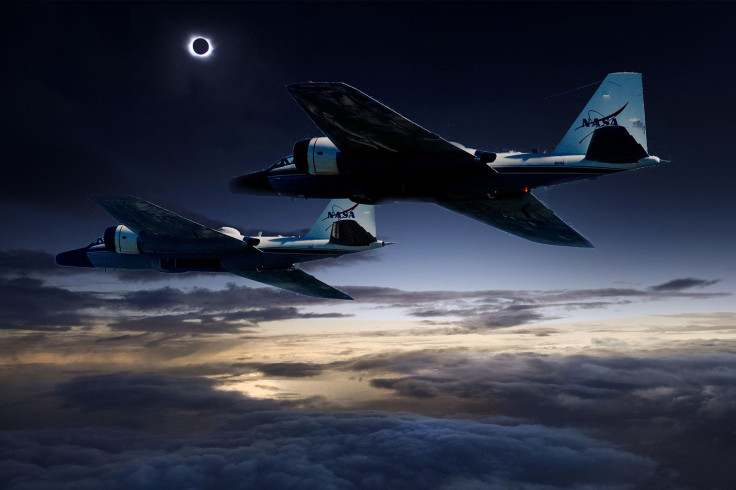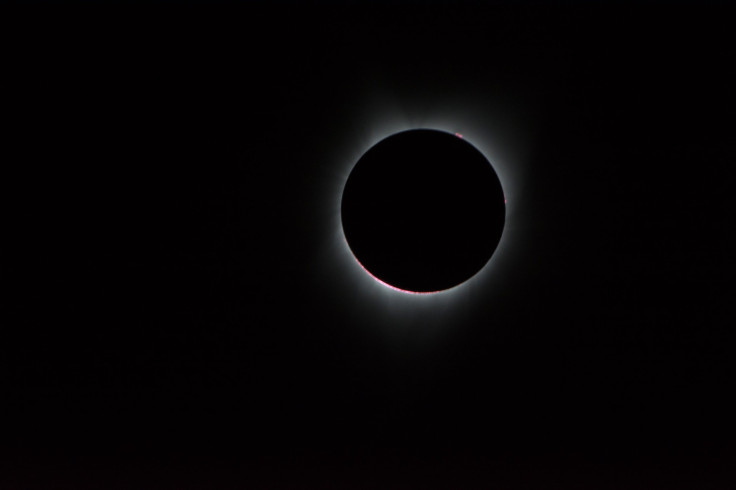NASA's Solar Eclipse Data Stuck On Jets In Post-Harvey Texas

The total solar eclipse offered the perfect opportunity for NASA to study eclipse conditions as well as the sun. The agency conducted more than 10 scientific studies during the eclipse to gather as much information as possible.
One of those missions involved flying two airplanes with telescopes on their noses along the path of totality while recording data the entire time. Those airplanes, as well as the data collected by them during the eclipse, are now sitting just outside of Houston, Texas, where Hurricane Harvey has been dropping feet of rain since the weekend.
The WB-57F jets that belong to NASA are housed at Ellington Field, about a half-hour drive outside of Houston, and roughly a third of the way from Houston to Galveston. Ellington Field is a Joint Reserves Base that’s currently being used to stage rescue operations for the Harvey aftermath.
“Of course our primary concern is for our friends and colleagues,” Amir Caspi, an astrophysicist at the Southwest Research Institute, who led the eclipse chasing mission, told International Business Times. “Data is not as important as people."
All seven minutes and 57 seconds of recorded data from the eclipse are stored redundantly on hard drives to keep it safe in case something happens to one of them. “From what I’m told Ellington Field is doing okay in terms of the damage,” Caspi said on Tuesday. But Caspi, who works out of Boulder, and his team don’t have access to that extensive scientific data yet. So far everything they’ve learned is from the initial “quick look,” or engineering data.
The goal of the mission was to capture extremely clear and extended data of the eclipse in visible and infrared wavelengths to learn about the sun, its corona and the planet Mercury. And to do this, of course, all from an airplane.
“We wanted to do this because being in a plane gives you several advantages,” said Caspi. Those advantages include increased observation time and height, which increases image quality because the photos can be taken from above most of the atmosphere.
To do this the jets that were affixed with telescopes built by the company Southern Research, flew in tandem at about 450 miles per hour, giving them each roughly four minutes in the eclipse's shadow. They followed one another and overlapped recording the eclipse by about 10 to 15 seconds. This made it possible to collect double the amount of data during the eclipse than solely one jet would have been able to capture, Caspi said.

“Definitely incredibly pleased with the actual acquisition of the data,” Caspi said adding that the planes were “Exactly where we needed to be exactly at the right moments.” But that being said, until the team has the scientific data in hand it will be hard to draw any scientific conclusions, “It's hard to know exactly what we're going to find,” Caspi told IBT.
The reason Caspi and his team chose the corona and Mercury as their eclipse subjects has more to do with what researchers don’t know that with what they do. The sun’s corona, the outermost part of the sun’s atmosphere, has been a point of interest for researchers since it was discovered to be far warmer than the surface of the sun. Caspi called this “counterintuitive” and said, “The classical ways we think of heat being transferred, those aren't very efficient in the corona.” Typically heat is transferred with convection, conduction or radiation, but not in the corona, so scientists like Caspi are determined to find out how heat there is transferred.
One theory, called wave heating, is that waves travel outwards along the magnetic field lines in the corona. Those field lines can be seen by the hot glowing gas that trace out loops. The waves carry energy, that can be dissipated as heat, Caspi explained.

In addition to the means by which heat transfers the researchers were looking at the structure of the corona, something computer models can’t predict and researchers can’t figure out. When models of the corona run they end up knotting, something that doesn’t happen in actuality but researchers are unsure why. “The corona is constantly untangling itself bit by bit. Every time it builds up a bit it releases. We’re trying to understand how the corona is releasing that,” Caspi said.
The reason for observing Mercury is that it can’t really be seen all the time, its proximity to the sun makes it difficult to observe. But during an eclipse, it’s high in the sky and the sky is dark which makes it far more visible. Caspi and his team were hoping to get enough data on Mercury using the infrared imaging to create a heat map of the planet. A heat map would give them insight into what the planet is made of and hypothetically how it formed. The engineering data isn’t detailed enough to conduct this research though, so those conclusions will be made at a later date as well.
There are five terabytes of data from this one mission, mainly because the telescopes were capturing the sun and Mercury at a rate of 30 frames per second. Caspi said once the team has the data in hand, “I imagine that it’ll probably take us a good few weeks once we have the science data in hand to get first cut and then the very detailed in depth analysis is probable going to take a few months.”
© Copyright IBTimes 2024. All rights reserved.





















